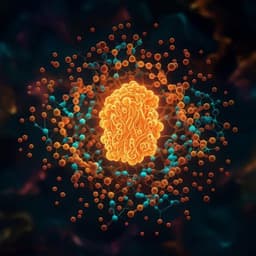Introduction
The lignocellulosic biorefinery industry, crucial for achieving carbon neutrality, suffers from low lignin valorization. Lignin, a significant component of lignocellulosic biomass (15-40% of total carbon), is often burned, contributing significantly to CO2 emissions. While various lignin valorization technologies exist, they only utilize a small fraction (around 2%) of the total industrial lignin. This inefficiency hinders the sustainability of biorefineries. Simultaneously, micronutrient malnutrition, or "hidden hunger," affects a third of the world's population, largely due to insufficient micronutrients (e.g., iron, zinc, calcium) in staple crops. Low iron bioavailability in alkaline soils, prevalent in a significant portion of arable land, exacerbates this problem. Synthetic chelators like EDTA improve metal bioavailability but are costly and environmentally harmful due to their non-biodegradability. Lignin, with its active functional groups, presents potential as a natural metal chelator. Natural lignin-derived compounds are the largest supply source of humic substances, known for enhancing metal nutrient bioavailability. This research investigated the potential of HSAL, a water-soluble lignin derivative, as a sustainable alternative to synthetic chelators.
Literature Review
Existing literature highlights the challenges of lignin valorization within the biorefinery industry and the global issue of micronutrient malnutrition. Studies have shown the potential of lignin-derived compounds, such as humic substances and lignosulfonates, to improve plant growth through metal chelation. However, the use of industrial lignin in fertilizers remains largely unexplored. The use of synthetic chelators such as EDTA is widespread but faces limitations due to their high cost and environmental impact. The paper reviewed the use of different strategies in producing monosaccharides in commercial biorefinery, particularly focusing on sulfuric acid hydrolysis and enzymatic hydrolysis and the characteristics of the lignin byproducts, which provides the background for the research.
Methodology
The study involved synthesizing HSAL from SAL via an alkaline hydrothermal reaction at 280 °C for 2 h. The chemical structure of HSAL was characterized using FT-IR, NMR, and elemental analysis to determine its methoxy and hydroxyl group content and average molecular weight. Its metal chelating capacity was assessed through the creation of HSAL-metal complexes with FeSO4, FeCl3, and CaCl2, followed by XPS and FT-IR analysis to identify chelation sites. Chelation capacity was quantified using chelatometric titration and compared to EDTA. The effect of HSAL on plant growth was investigated using rice (Oryza sativa), corn (Zea mays), and Arabidopsis thaliana under various nutrient conditions. Root growth was assessed by measuring root length and biomass. Cellular mechanisms were studied via cell number and size analysis and EdU staining for cell proliferation assessment. Genome-wide transcriptomic analysis (RNA-seq) was employed to identify genes affected by HSAL treatment in rice. Quantitative real-time PCR was used to validate the gene expression results. Chlorophyll content and elemental analysis (ICP-MS and MP-AES) were used to assess iron and other nutrient accumulation in plants. Finally, the cost-effectiveness of HSAL production was assessed by considering energy and material costs.
Key Findings
The hydrothermal treatment effectively depolymerized SAL, reducing methoxy groups and increasing phenolic hydroxyl groups, leading to water solubility. HSAL demonstrated a significant metal chelating capacity, particularly for Fe3+ and Ca2+, comparable to EDTA. Application of HSAL significantly enhanced root length and biomass in rice, corn, and Arabidopsis, under both nutrient-sufficient and deficient conditions. In rice, the increased root length was attributed primarily to increased cell proliferation rather than cell elongation. Transcriptomic analysis revealed that HSAL treatment influenced the expression of genes related to metal nutrient transport and iron-related processes. HSAL significantly improved iron bioavailability, particularly under iron-deficient conditions, rescuing growth defects observed in iron-deficient plants. The increased iron accumulation in plants treated with HSAL was not solely due to direct contamination from the HSAL itself. Furthermore, HSAL's beneficial effects extended beyond iron, also improving the bioavailability of other micronutrients such as calcium, magnesium, copper, and zinc. The effects of HSAL on iron uptake in Arabidopsis suggested it functions similarly to EDTA as a ferric iron chelator, requiring FRO2 and IRT1 for uptake. Economic analysis suggested that HSAL production costs are significantly lower than those for synthetic chelators.
Discussion
The findings demonstrate HSAL's potential as a sustainable alternative to synthetic iron chelators. Its effectiveness in improving iron bioavailability in both monocot and dicot plants highlights its broad applicability. The mechanism appears to involve chelation of ferric iron, enhancing its mobility and accessibility to plant roots and preventing precipitation in cell walls. The results highlight the importance of considering both the environmental impact and economic viability of nutrient management strategies. HSAL addresses both by offering a cost-effective and environmentally friendly approach to micronutrient supplementation. The broad impact on multiple nutrient availabilities suggests that HSAL's use could reduce the reliance on multiple synthetic chelators, potentially streamlining nutrient management practices while minimizing environmental risks.
Conclusion
This research successfully demonstrates the potential of HSAL, a sustainable lignin-derived material, as a potent metal chelator for improving plant nutrient bioavailability. The cost-effectiveness and environmental benefits of HSAL compared to synthetic chelators make it a promising solution for enhancing crop growth and addressing micronutrient malnutrition. Future research could focus on optimizing HSAL production, investigating its long-term effects on soil health, and exploring its application in diverse agricultural settings. Further studies are needed to determine if there are negative effects on soil biology.
Limitations
The study primarily focused on the effects of HSAL on plant growth under controlled laboratory conditions. Further research is needed to assess the effectiveness of HSAL under various field conditions and in different soil types. The long-term effects of HSAL on soil ecology and microbial communities require further investigation. While the economic analysis provides valuable insights, a more comprehensive life cycle assessment might be necessary to fully capture the environmental impact of HSAL production and application.
Related Publications
Explore these studies to deepen your understanding of the subject.






